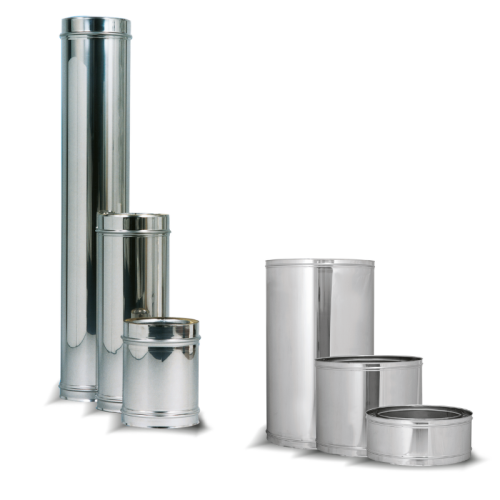Flue pipes
Flue systems: essential for the safety and efficiency of heating systems
Flue systems are crucial components for the proper operation and safety of heating systems, including boilers, fireplaces, and stoves. These exhaust systems are designed to safely remove combustion gases and fumes, ensuring a secure and comfortable indoor environment.
In this article, we will explore the characteristics of flue systems, their benefits, how they work, and key considerations for their selection and installation.
Page: 1 di 1
Characteristics of flue systems
- Materials used: Flue systems can be made from various materials, including stainless steel, carbon steel, ceramic, and plastic. The choice of material depends on the type of fuel used and the operating conditions.
- Types: There are different types of flue systems, including single-wall flues, double-wall (insulated) flues, and ceramic flues. Each type has specific applications and advantages.
- Size and diameter: Flue systems come in various sizes and diameters to accommodate different heating systems and fume evacuation requirements. Choosing the right size is essential to ensure efficient fume flow.
- Thermal insulation: Insulated flue systems, featuring a double-wall structure with thermal insulation, provide better performance in terms of safety and energy efficiency, reducing heat loss and preventing condensation.
- Corrosion resistance: Flue systems must be resistant to corrosion caused by combustion gases and moisture. Stainless steel, for example, offers excellent anti-corrosion properties.
Functions of flue systems
- Fume evacuation: Flue systems transport combustion fumes and gases from the interior of a building to the outside, leveraging the natural tendency of hot gases to rise. Proper flue sizing and design facilitate this process.
- Condensation prevention: Insulated flue systems reduce the risk of condensation formation within the system, preventing corrosion and improving fume flow efficiency.
- Natural draft: The natural draft is the upward movement of hot gases through the flue system, which aids in fume evacuation. A good draft is essential for efficient combustion and to prevent fumes from returning into indoor spaces.
- Emission control: Modern flue systems are designed to minimize pollutant emissions, ensuring that combustion gases are safely expelled while complying with environmental regulations.
Installation and maintenance of flue systems
- Material selection: Choosing the right flue system material depends on the type of fuel used (wood, gas, pellets) and operating conditions. Corrosion-resistant and high-temperature materials are essential for demanding applications.
- Sizing and diameter: Determining the correct size and diameter of the flue system is crucial to ensuring an efficient draft and proper fume flow. Undersized or oversized flue systems can compromise the performance of the heating system.
- Thermal insulation: Consider using insulated flue systems to enhance energy efficiency and prevent condensation. Thermal insulation is particularly important in cold environments.
- Professional installation: Ensure that flue system installation is carried out by qualified professionals to guarantee compliance with regulations and system safety.
- Regular maintenance: Schedule periodic maintenance of flue systems, including internal cleaning and inspection of joints, to maintain performance and safety over time.







